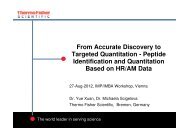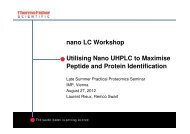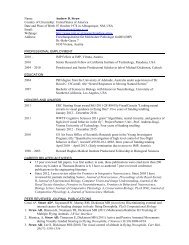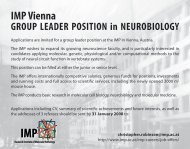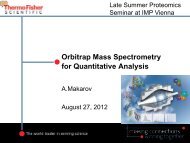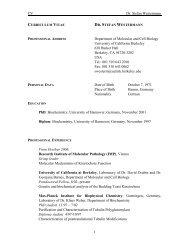IMP Research Report 2002
IMP Research Report 2002
IMP Research Report 2002
You also want an ePaper? Increase the reach of your titles
YUMPU automatically turns print PDFs into web optimized ePapers that Google loves.
cDNA-library from facial mesenchyme cultured in the<br />
presence or absence of FGF and have used this library<br />
to produce a customized DNA microarray. This microarray<br />
was probed with cDNA derived from mesenchyme<br />
cultured with or without FGF. The expression pattern<br />
of 200 clones with the strongest differential hybridization<br />
was then analyzed by whole mount in situhybridization<br />
and inducibility by FGF8 was confirmed. Through this<br />
screen we have identified more than 50 genes that are<br />
induced in the facial mesenchyme in response to FGF<br />
signaling and we have begun to characterize some of<br />
Figure 2: Tissue specific inactivation of Fgf8 in the facial area<br />
results in severe facial defects. Facial expression of Fgf8 at E9.5<br />
(A) and E10.5 (B). The face of a wildtype (C) and an Fgf8 mutant<br />
embryo (D) at E16.5. Embryos in which Fgf8 has been inactivated<br />
in the facial area develop a midfacial cleft and show a severe<br />
reduction of the lower jaw and peri-ocular tissue.<br />
them. We believe that this analysis will ultimately help<br />
to understand the function of FGF signaling during<br />
development at the molecular level.<br />
the development of the nasal placodes and the<br />
surrounding ectoderm is abnormal in Fgf8 mutant<br />
embryos. This includes changes in the expression<br />
patterns of ectodermal signaling molecules. Therefore,<br />
altered signaling between the mutant ectoderm and the<br />
underlying mesenchyme is likely to contribute to the<br />
defects observed at later stages.<br />
Identification of genes transcriptionally<br />
regulated in facial mesenchyme in<br />
response to FGF signaling<br />
In order to understand how FGF8 controls development<br />
of the facial mesenchyme it is important to identify the<br />
genes induced or repressed in response to FGF8<br />
signaling. We are using an in vitro explant culture<br />
system in which facial mesenchyme is cultured in<br />
contact with facial ectoderm, in isolation or in contact<br />
with polymeric beads soaked in FGF8 protein, to identify<br />
such genes (Figure 3).<br />
Figure 3: Identification of FGF-inducible genes. Facial mesenchyme<br />
was cultured in vitro with FGF or PBS soaked beads. RNA was<br />
isolated from these explants and used to generate a subtracted<br />
(SSH) cDNA-library, enriched for FGF inducible clones. The inserts<br />
of 4400 clones from this library were then arrayed on glass slides.<br />
The resulting microarray was hybridized with probe derived from<br />
RNA isolated from facial mesenchyme cultured with FGF or PBS<br />
soaked beads, labeled with a green or red fluorescent dye (Cy3 or<br />
Cy5), respectively.<br />
Using a candidate approach, we have shown that FGF<br />
signaling induces the expression of the transcription<br />
factors Pax3, Tbx2, Erm and Pea3 in facial<br />
Contact: neubueser@imp.univie.ac.at<br />
mesenchyme. To systematically screen for FGF<br />
inducible genes, we have generated a subtracted<br />
35




